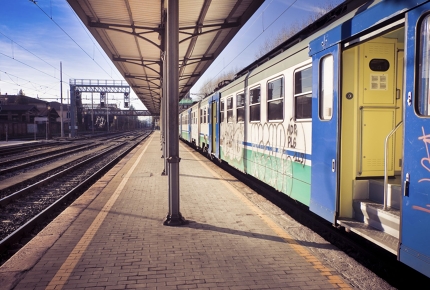Is it the end of the line for InterRail?
Inter-railing around Europe has been a rite of passage for backpackers since the 1970s, but is its appeal waning? Our resident rail anorak, Gavin Haines, investigates.
“Heads Barcelona, tails Berlin.” The summer of 2003 was capricious and carefree. Keen to broaden our horizons my pal and I decided to go inter-railing around Europe and agreed to allow fate – the flip of a coin – to determine our course.
Said coin steered us to 16 countries in all, but it was our dog-eared InterRail passes that truly opened the door to these destinations, allowing us unlimited travel on Europe’s extensive rail network.
Rattling across the continent, we watched landscapes unfold, bantered with locals and saved what little money we had by sleeping aboard musty night trains; nodding off in one European capital (usually with the help of alcohol) and waking in another. They were footloose and fancy-free days. I don’t think I have enjoyed such unbridled freedom since.
Trailblazing we were not. The first InterRail tickets were issued way back in 1972 and since then hundreds of thousands of wet-behind-the-ears backpackers have taken to the rails to discover this great continent from the comfort of a train carriage.
The question is: how many more will follow in their footsteps?
Hidden costs
Until recently InterRail had endured for two main reasons; one, because it offered unimpeded freedom to explore the continent and, two, because the passes were cheap.
They still are to an extent: if you’re lucky enough to be under 26, you can pick up a one-month “global” InterRail pass for €461 (or €392 if you get in on the current sale), but if you’re old like me you'll have to pay €983 for the same ticket (or €836 in the sale).
Not bad for unlimited European travel, you might say. But that’s the problem: these passes no longer offer unlimited travel, at least not like they used to.
“In France, Spain and Italy they sell train tickets like they do plane tickets,” says Mark Smith, editor of the excellent Man in Seat 61. “Every single ticket requires a reservation even with an InterRail pass… whereas in the good old days you could just hop on any train and flash your pass without paying extra.” (This is still possible on some local train services, where no reservation is required).
Reserving a seat on long-distance trains in France, Italy or Spain will typically cost around €10, but you may have to pay considerably more, warns Mark.
“There are a couple of trains such as Paris to Milan where the surcharge is something ridiculous like €55,” he says. “You need to budget for it because the costs add up.”
Ultimately, in those countries InterRail tickets have lost their convenience factor and could actually cost passengers more than regular train tickets.
“Europe really does divide down the middle on this supplement thing,” he says. “The passes retain their convenience factor in Central and Eastern Europe, but have lost it in much of Western Europe.”
 Inter-railing has been a rite of passage for backpackers since 1972
Inter-railing has been a rite of passage for backpackers since 1972PetarPaunchev / Thinkstock
Cheaper alternatives
The economic case for inter-railing – particularly if you’re over 26 – has been weakened elsewhere in Europe thanks to the introduction of low-cost advanced fares by rail operators.
“The whole of Western Europe has got airline-style rail fares now and if you book in advance you can go from Paris to Milan for €29,” explains Mark. “So what you’ll probably find is that InterRail passes might save money against the expensive turn-up-at-the-station fares, but if you know your itinerary in advance and can pre-book tickets that is the cheapest way of doing the journey.”
Ultimately, the question is: are you prepared to book ahead and commit or do you demand flexibility? If it’s the latter, an InterRail ticket might still be worth it.
Budget airlines have also undermined the case for splashing out on an InterRail pass, though darting between cities in a 737 lacks the romance of rail travel; watching the scenery go by, talking pidgin Hungarian with locals and getting off at random stations on a whim.
“There are many beautiful places between the cities and with a train you are able to see these places,” says Ceren Burcak Dag, who’s just returned from inter-railing around the Balkans. “[With an InterRail ticket] it is possible to get off at an arbitrary stop – a village or town – and have a look around.”
The flexibility offered by InterRail was a godsend for Chris Swindells, who had to alter his plans last minute when he was travelling around the Balkans last year.
“One morning, sat nursing a hangover in a hostel in Budapest, we turned on the TV to see awful images of flood-ravaged countryside and locals desperately waving at helicopters from their rooftops,” he says. “It was only when we turned up the volume that we realised their location and the significance for us: the footage was from Serbia and Bosnia-Herzegovina, our next destinations.”
Chris was due to take the sleeper train to Belgrade that night and stay in a floating hostel on the Danube, which, all things considered, might have seemed one of the better places to stay in Serbia. Not so.
“We had an email from the hostel owners, which effectively terminated the booking,” he says. “They were worried the hostel would float away.”
Thanks to the flexibility of his InterRail ticket, Chris jumped aboard a train to Slovenia instead, an altogether drier destination. But back at home he did the maths and worked out his InterRail ticket probably hadn’t saved him money on his Balkan odyssey, where train travel is cheap.
And that’s the problem with inter-railing today. As the one-size-fits-all approach to rail travel has died in Europe, so too have the days when you could buy a pass and travel unhindered around the continent without having to make reservations, pay fees or worry about cheaper tickets.
“It’s a shame,” says Mark, who travelled from London to Greece by train in 1984. “I think people are missing out on the experience I had in the 1980s. I suppose every generation says that; maybe every generation is right.”
 The romance of taking the train around Europe endures
The romance of taking the train around Europe enduresFrancesco Scatena / Thinkstock
Is InterRail worth it for you?
• If you’re travelling in France, Spain and Italy seat reservations are mandatory on every train – even if you have an InterRail pass. Making reservations incurs a fee (typically €10) and can negate the economic benefits of an InterRail ticket.
• Western European rail operators sell advanced, airline-style fares that, cumulatively, can work out significantly cheaper than an InterRail ticket. If you can book in advance and stick to your plans, this is often the cheapest way to travel.
• InterRail passes have largely retained their convenience factor in Central and Eastern Europe, where reservations are not necessary. They can also work out more economical because rail fares are typically fixed there.
• InterRail tickets are also valid on some coach and ferry services, which can make them more appealing for some travellers.
• There is currently a 15% discount for InterRail customers starting their trip before May, which could tip the balance for many travellers.
• Arguably, families have the most to gain from buying an InterRail ticket – a child under 12 can travel for free with an adult.
Liked this? Then have a read of these:
10 of the best night trains in Europe
The best train journeys in Britain
Russia by train: A journey aboard the Trans-Siberian Express
A rail journey into the heart of Mongolia
Do you have any Feedback about this page?
© 2025 Columbus Travel Media Ltd. All rights reserved. No part of this site may be reproduced without our written permission, click here for information on Columbus Content Solutions.









 You know where
You know where